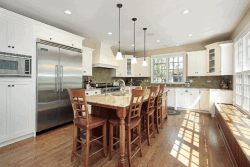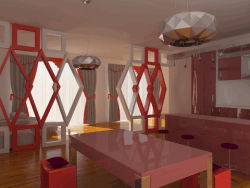Kitchen Pendant Lighting: Attractive Ambient Lighting Fixtures
Kitchen pendant lighting provides multi-directional ambient lighting while providing attractive fixtures.
Kitchen pendant lighting provides unique qualities of lighting to your kitchen lighting design. Other standard forms of lighting, from recessed lighting to track lighting to under-cabinet lighting, each have their own difficulties for providing proper ambient lighting to your kitchen spaces. Specifically, none is especially good at providing multi-directional lighting that can provide you with general illumination. Kitchen pendant lighting, on the other hand, shines in all directions. Moreover, kitchen pendant lighting allows you to express your own sense of style using the fixtures themselves.
Problems With Other Forms of Kitchen Lighting
Each of the other popular forms of lighting has its own problems in providing you with general illumination because of the way that their light is directed:

Notice how the pendants shine light in all directions, while the recessed lighting only shines downwards .
- Recessed Lighting: Recessed lighting fixtures have a number of difficulties properly lighting kitchens. Primarily, the difficulty is that the light shines almost completely downwards. This causes problems with tasks because of the shadows cast. It also provides problems with general illumination. Your countertops will be well lit (assuming you aren’t actually using them). However, your walls and any other surfaces will not be well illuminated. Moreover, faces look terrible under recessed lighting, as harsh shadows are cast, accentuating wrinkles.
- Track Lighting: Kitchen track lighting still shows its origins in museums. The light is directed at a particular spot, which is excellent for highlighting accents, but doesn’t provide quality general illumination. Your walls and accents will be well lit, but any ambient light will come from reflected light. (Note that I am speaking here of track spot lighting, not pendants on tracks).
- Under-Cabinet Lighting: Under-kitchen-cabinet lighting provides some of the best available kitchen task lighting. However, it is poor for providing general illumination. Because the light is tucked under your cabinets, anything above the bottom of your cabinets is hardly lit at all.
Advantages of Kitchen Pendant Lighting

The more light sources you use, the more your kitchen will seem to sparkle.
In addition, kitchen pendant lighting can actually contribute to your task lighting. Because under-cabinet lighting is impossible on kitchen islands and both recessed and track lighting cast harsh shadows that can make food preparation dangerous, pendant lighting is often your best source for kitchen task lighting over kitchen islands. The trick is to make sure that someone working on the island doesn’t block all of the lights. A string of pendants across the length of the island will work nicely.
Finally, kitchen pendant lighting is excellent for illuminating eating areas in your kitchen. By placing a pendant or pendants over the eating area, each person eating will have their faces well illuminated above and from the front, which is one of the most complimentary angles from which the face can be lit. Inclusion of pendants in your dining nook creates a far more welcoming and attractive space both for your family and for your guests.
Some Cautions
There are some things of which you should be cautious when using pendant lighting in your kitchen. However, they can all be avoided with a little planning:
- Glare Bombs: One of the most common mistakes using kitchen pendant lighting (and indeed, one of the main reasons that designers somewhat turned away from them) is the creation of a “glare bomb”. A “glare bomb” is a single, bright source of light that either provides the sole source of illumination in a room or its primary source of illumination. Because all of the light is concentrated in a single space, it becomes unpleasant to look at and actually dims the rest of the room by contracting your irises.
Instead, make sure to spread out your pendants or use them for background, ambient illumination rather than try to have them do too much work in themselves. One common theme in contemporary lighting is to use multiple sources of light. For instance, instead of using one large pendant over your kitchen table, try instead three or four smaller pendants. This won’t have the same blinding effect. Similarly, if you do wish to use a single pendant, try instead to use one with multiple source of light on that one pendant, such as a basic chandelier.
- Glare on Countertops: Granite countertops are a wonderful addition to many homes, however, they come with their own set of issues. Specifically, they are “semi-specular”, meaning that, while not a mirror, one can still see images reflected in them. When a light source is reflected into a viewer’s eyes, this creates glare. Wherever you place your pendants, make sure that there are not spots in your room when people can’t look at the counter when the light is on. If you can’t move a pendant, you can use a translucent shade on the pendant where it would otherwise shine a reflection into someone’s eyes.
- Integration: When creating your kitchen lighting layout, it is important to keep the different parts of your kitchen relatively balanced in their brightness. If you decide to put pendants over your kitchen area, you need to think of what will balance out that brightness in your food preparation area. Conversely, kitchen table pendants might be a great way of ensuring that you can balance out the brightness of the task lighting in your food preparation area.
- It overcomes some of the defects of recessed, track and under-cabinet lighting when it comes to ambience.
- It can provide excellent light for faces, countertops and for balance.
- It is important to avoid various types of glare when using such potentially blinding light sources.
- The fixtures themselves can be expressive of your own personality and sense of style.

Your choice of kitchen pendant styles is only limited by your imagination.
A number of different styles exist. For a more classic style, you might consider Tiffany-style pendants with stained-glass shades or even a small chandelier, if you think that your kitchen can live up to that level of formality. There are also less ostentatious fixtures that you can use if you don’t want to divert too much attention to your lighting fixtures. Finally, there is a wide variety of exciting contemporary ceiling lighting available that ranges between the sharp, the funky and the subversive, depending on your taste. Whatever you decide to do, consider what fixtures suit both you and your kitchen’s personalities best.
Putting It All Together
Kitchen pendant lighting is a wonderful way of providing your room with multi-directional ambient lighting:
Kitchen pendant lighting, therefore, provides unique contributions to the quality of light in your kitchen.
Back from Kitchen Pendant Lighting to Kitchen Lighting Ideas